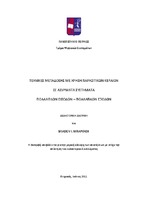Τεχνικές μετάδοσης με χρήση παρασιτικών κεραίων σε ασύρματα συστήματα πολλαπλών εισόδων - πολλαπλών εξόδων

Doctoral Thesis
Author
Μπαρούσης, Βλάσιος Ι.
Date
2011-06-29View/
Abstract
The dissertation deals with the problem of large dimensions and hardware implementation complexity of multiple input – multiple output (MIMO) systems. Despite the significant benefits of MIMO technology, often these drawbacks hinder its wide deployment to modern communication systems. To overcome these problems a lot of techniques have been proposed that focus on the design of compact antenna arrays with reduced dimensions and on some algorithms based on signal processing principles that allow for the reduction of the effective number of RF chains. In contrast to these well‐known techniques, the research activity in this dissertation focuses on the study and performance evaluation of a novel MIMO architecture that instead of conventional arrays utilizes ESPAR antennas with just a single active and several parasitic antenna elements. This kind of antennas allows for the drastic reduction of the antenna dimensions and the implementation complexity, since it requires only a single RF chain and strong coupling between adjacent antenna elements to produce the desired radiation patterns. The hardware restrictions of ESPAR antennas however, prohibit their direct application to conventional MIMO transceivers because the spatial dispersion of the transmit signals and the spatial sampling of the impinging signals at the receiver is not possible. Instead, MIMO systems with a single RF chain have to be studied at the beamspace domain (BS) of ESPAR antennas. Consequently, a method to study ESPAR antennas at the BS domain is proposed, which among others, allows for the estimation of their effective aerial degrees of freedom as a function of the geometrical characteristics of such antennas.



